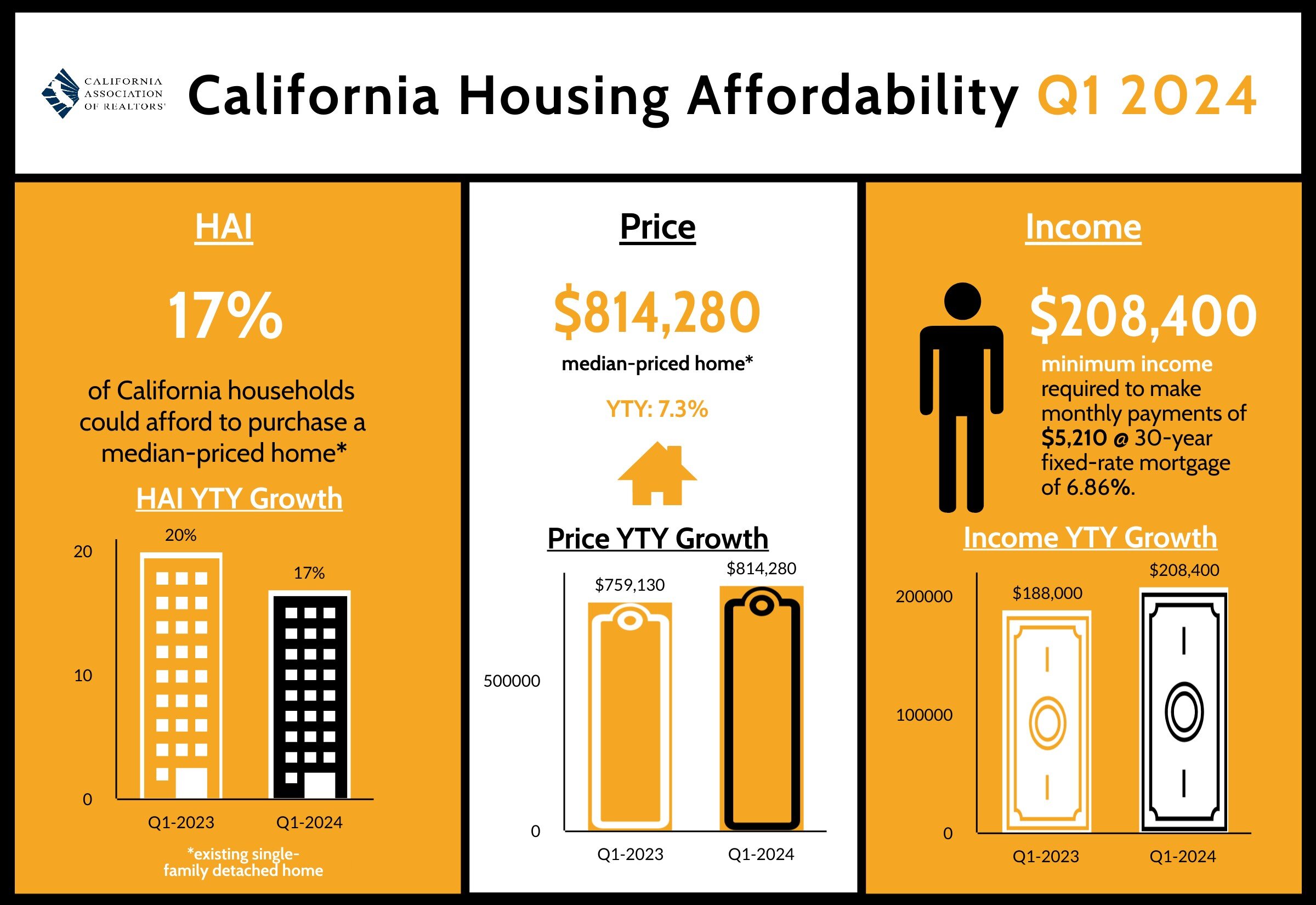Residential Real Estate News

Only 17 Percent of Current Residents Can Afford to Buy a California Home in 2024
Residential News » Los Angeles Edition | By Michael Gerrity | May 17, 2024 8:37 AM ET
The California Association of Realtors is reporting that only seventeen percent of the state's homebuyers could afford to purchase a median-priced, existing single-family home in California in the first-quarter 2024.
This is up from 15 percent in the fourth quarter of 2023 and down from 20 percent in the first quarter of 2023, according to C.A.R.'s Traditional Housing Affordability Index (HAI). The first-quarter 2024 figure is less than less than a third of the affordability index peak of 56 percent in the first quarter of 2012. With the U.S. economy performing better than expected, the Federal Reserve is unlikely to cut interest rates until at least the summer, hindering any significant improvement in affordability in the coming months.
C.A.R.'s HAI measures the percentage of all households that can afford to purchase a median-priced, single-family home in California. C.A.R. also reports affordability indices for regions and select counties within the state. The index is considered the most fundamental measure of housing well-being for home buyers in the state.
A minimum annual income of $208,400 was needed to qualify for the purchase of a $814,280 statewide median-priced, existing single-family home in the first quarter of 2024. The monthly payment, including taxes and insurance (PITI) on a 30-year, fixed-rate loan, would be $5,210, assuming a 20 percent down payment and an effective composite interest rate of 6.86 percent.
The effective composite interest rate was 7.39 percent in fourth-quarter 2023 and 6.48 percent in first-quarter 2023. With recent economic reports showing a lack of progress on the inflation battle in recent months, the Federal Reserve's plan to cut rates this year has been further delayed, and a downward adjustment in the fed funds rate may not take place until late summer.
The share of California households that could afford a typical condo/townhome in first-quarter 2024 rose to 24 percent, up from 22 percent recorded in the previous quarter but fell from the 27 percent recorded in the first quarter of 2023. An annual income of $167,600 was required to make the monthly payment of $4,190 on the $655,000 median-priced condo/townhome in the first quarter of 2024.
Compared with California, nearly four in 10 of the nation's households could afford to purchase a $389,400 median-priced home, which required a minimum annual income of $99,600 to make monthly payments of $2,490. Nationwide affordability was down from 40 percent a year ago.
Key points from the first-quarter 2024 Housing Affordability report include:
- When compared to the previous quarter, housing affordability declined in four counties and remained unchanged in ten. Thirty-nine counties showed quarter-to-quarter improvements in affordability due to lower interest rates and more modest price declines, compared to other counties during the same time period. When compared to a year ago, six counties registered an improvement in affordability, while 46 counties throughout the state posted a decline on a year-over-year basis, and only one remained unchanged.
- Lassen (51 percent) remained the most affordable county in California. Tehama (39 percent), followed by Plumas (37 percent), Shasta (37 percent) and Tuolumne (36 percent) trailed behind and were the only five counties in California to record an affordability index greater than 35 percent. Of all counties in California, Lassen continued to have the lowest minimum qualifying income ($66,000) to purchase a median-priced home in first-quarter 2024.
- Mono (4 percent), San Luis Obispo (10 percent) and a four-way-tie at 11 percent between Orange, San Diego, Monterey, and Santa Barbara, were the least affordable counties in California, with each of them requiring a minimum income of at least $222,000 to purchase a median-priced home in the respective counties. San Mateo continued to require the highest minimum qualifying annual income ($511,600) to buy a median-priced home in the first quarter of 2024 and was the only county in the state requiring a minimum qualifying income over $500,000. Santa Clara County came in second, requiring a minimum income of $470,800, followed by Marin ($427,200).
- Housing affordability declined the most on a year-over-year basis in Siskiyou, falling nine percentage points from the previous quarter. Plumas and Mendocino recorded the second biggest drop in affordability, moving five percentage points below the same quarter of last year. Despite a growth in household income, higher home prices and elevated mortgage rates continue to keep housing affordability near its all-time low across most counties.
Sign Up Free | The WPJ Weekly Newsletter
Relevant real estate news.
Actionable market intelligence.
Right to your inbox every week.
Real Estate Listings Showcase
Related News Stories
Residential Real Estate Headlines
- Las Vegas Area Home Prices Uptick 4.3 Percent Annually in March
- Single-Family Rent Growth in U.S. Trends Upward in 2025
- U.S. Mortgage Rates Tick Down Post Trump Tariffs Commencement
- President Trump's 'Liberation Day' Tariffs Potential Impact on the U.S. Housing and Mortgage Markets
- Baby Boomers Biggest Cohort of U.S. Home Buyers in 2025 as Millennials Decline
- U.S. Monthly Housing Payments Hit Record High in 2025
- U.S. Pending Home Sales Uptick in February
- Global Prime Residential Rent Slowdown Continued in Late 2024
- Ireland Home Price Inflation Hits 8 Year High in Early 2025
- Existing Home Sales in America Uptick in February
- Great Miami Area Residential Sales Decline 15 Percent Annually in February
- Mortgage Rates Uptick in Mid-March, Ending 9-Week Decline in U.S.
- World Property Ventures Builds the Future of Real Estate with New Funding Round
- U.S. Builder Sentiment Declines Amid Economic Uncertainty and Rising Costs
- Black Homeownership Rates in U.S. Enjoy Largest Annual Increase of All Racial Groups
- Wealthy Renters Are Taking Over More of the U.S. Rental Market
- If U.S. Congress Does Not Extend NFIP Soon, Thousands of Daily Home Closings Impacted
- U.S. Mortgage Applications Spike 11 Percent in Early March
- Greater Palm Beach Area Residential Sales Rise in Early 2025
- New Apartments in U.S. Are Leasing at Slowest Pace on Record
- U.S. Mortgage Rates Drop to 4 Month Low in March
- Overall U.S. Mortgage Delinquency Rates Dip in December
- New Tariffs on Canada, Mexico to Impact U.S. Homebuilder Input Costs
- Monaco's Property Market: A Tale of Two Cities
- U.S. Home Purchase Cancellations Surge, 1 in 7 Sales Getting Canceled
- U.S. Pending Home Sales Hit Historic Low in Early 2025
- Greater Miami Area Residential Sales Dip in January
- Governor DeSantis Supports Ending Property Taxes in Florida
- WPV Aims to Become the Berkshire Hathaway of Real Estate Tech
- U.S. Home Sales Slump Continues in January
- Average Americans Spend 38 Percent of Monthly Income on Mortgage Payments
- Switzerland's Safe-Haven Appeal Grows with World's Wealthy Homebuyers
- U.S. Builder Confidence Rapidly Declines in February
- Las Vegas Home Sales Rise 6.7 Percent Annually in January, Condo Sales Dip
- Homebuyer Demand in America Drops to 5-Year Low in Early 2025
- Ownership More Affordable Than Renting in Most U.S. Markets
- The World's First Global Listings Service Launches, Called a GLS
- Home Prices Continue to Rise in 89 Percent of U.S. Metros in Late 2024
- Global Luxury Residential Prices Showed Gradual Improvement in Late 2024
- U.S. Construction Hiring Rate Drops to Lowest Levels in 5 Years






